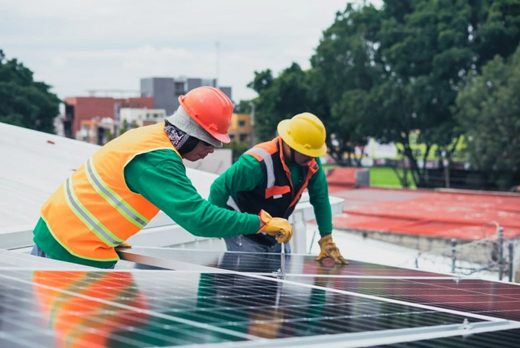Smart strategies for cutting solar panel installation costs at home, House power technology advice
Smart Strategies for Cutting Solar Panel Installation Costs
24 April 2025
Are you thinking about installing solar panels? It’s a great step towards sustainable living and can lead to significant savings on your energy bills. However, getting a handle on the costs is essential before diving in. Solar panel installation isn’t just about buying the panels themselves; several factors contribute to the overall expense.
These include the cost of equipment, labor fees, and necessary permits. Equipment costs can vary based on the type and efficiency of the panels you choose. Labor costs depend on the complexity of the installation and can differ by location. Permits are essential for compliance with local regulations, and their costs can vary regionally. Understanding these components will help you make an informed decision and ensure you’re prepared for all aspects of your solar investment.
Understanding the Basics of Solar Panel Installation Costs
Experts at Sun Valley Solar Solutions emphasize that when considering solar panel installation, it’s essential to understand the various components that contribute to the overall cost. These costs typically include equipment, labor, and permits. Equipment costs can vary significantly depending on the type and efficiency of the solar panels you choose. Labor costs are influenced by the complexity of the installation and can differ based on your location. Additionally, permits are necessary to ensure compliance with local regulations, and their costs can fluctuate depending on regional requirements. It’s important to note that these expenses can vary not only by location but also by the size of the system you plan to install.
To get a clear picture of what you might expect to pay, it’s advisable to obtain multiple quotes from different solar providers. This approach allows you to compare market rates and ensures you’re getting a fair deal. Here are some steps you can take:
Research local solar companies: Look for reputable providers in your area with positive customer reviews.
Request detailed quotes: Ensure each quote includes a breakdown of equipment, labor, and permit costs.
Compare warranties and services: Consider not just the price but also the warranties offered and any additional services provided.
By taking these steps, you’ll be better equipped to make an informed decision about your solar panel installation, potentially saving money in the process.
Exploring Financial Incentives and Tax Credits
When considering solar panel installation, it’s essential to explore the various financial incentives and tax credits available that can significantly reduce your initial investment. The federal government offers a substantial solar tax credit known as the Investment Tax Credit (ITC), which allows you to deduct a percentage of your solar installation costs from your federal taxes. As of now, this credit stands at 30%, but it’s crucial to stay updated on any legislative changes that might affect this percentage in the future. In addition to federal incentives, many states provide their own rebates and credits, which can further decrease the upfront costs. It’s worth researching what specific incentives are available in your state to maximize your savings.
Understanding how these tax credits work is vital for making the most out of your solar investment. Essentially, these credits reduce the amount of tax you owe dollar-for-dollar. For instance, if your solar installation costs $20,000, a 30% tax credit would allow you to deduct $6,000 from your federal taxes. However, it’s important to note any deadlines associated with these incentives; missing them could mean losing out on significant savings. Additionally, some states have specific policies or deadlines that might change annually, so keeping an eye on local legislation is beneficial.
By taking advantage of these financial incentives and staying informed about policy changes, you can effectively lower the cost of going solar and enhance the return on your investment.
Choosing the Right Solar Panel System for Your Needs
When selecting a solar panel system that aligns with your energy needs and budget, it’s essential to consider the various types of panels available. Solar panels come in different forms, each with its own efficiency and longevity characteristics. For instance, monocrystalline panels are known for their high efficiency and long lifespan, making them a popular choice for those looking to maximize energy production in limited space. On the other hand, polycrystalline panels offer a more cost-effective solution with slightly lower efficiency but still provide reliable performance. Additionally, thin-film panels are lightweight and flexible, suitable for unconventional installations but generally less efficient than crystalline options.
To determine the appropriate system size for your home, start by assessing your current energy consumption. Review your electricity bills to understand your average monthly usage in kilowatt-hours (kWh). This will help you estimate the number of panels needed to meet your energy demands. It’s also wise to consider potential future changes in energy use, such as purchasing an electric vehicle or adding new appliances. By doing so, you can ensure that your solar panel system is scalable and adaptable to your evolving needs. Here are some tips to guide you:
Analyze past utility bills: Look at at least six months’ worth of data to account for seasonal variations.
Consider energy-efficient upgrades: Implementing measures like improved insulation or smart thermostats can reduce overall consumption.
Consult with professionals: A reputable solar installer can provide insights into optimal system sizing based on your specific circumstances.
Selecting the right solar panel system involves balancing efficiency, cost, and future-proofing to ensure you make a sound investment that meets both current and future energy needs.
Financing Options for Solar Panel Installation
When considering solar panel installation, understanding the various financing options can significantly impact your overall savings. There are several ways to finance your solar investment, each with its own set of advantages and disadvantages. One popular option is taking out a solar loan, which allows you to own the system outright while paying off the cost over time. This method often results in higher long-term savings compared to leasing, as you benefit directly from tax credits and increased home value. However, it’s essential to consider interest rates and loan terms to ensure they align with your financial goals.
Another viable option is entering into a lease agreement or a Power Purchase Agreement (PPA). These arrangements typically involve little to no upfront costs, making them attractive for those who prefer minimal initial investment. With a lease, you pay a fixed monthly fee for using the solar panels, while a PPA involves paying for the electricity generated at a predetermined rate. While these options can provide immediate savings on energy bills, they may offer fewer long-term financial benefits compared to owning the system. It’s crucial to weigh these factors carefully and consider your personal financial situation when deciding on the best financing route for your solar panel installation.
Maximizing Savings with Energy Efficiency Measures
Before diving into solar panel installation, it’s wise to explore ways to enhance your home’s energy efficiency. By doing so, you can significantly reduce your overall energy consumption and maximize the benefits of your solar investment. One effective strategy is to improve your home’s insulation. Proper insulation helps maintain a consistent indoor temperature, reducing the need for excessive heating or cooling. This not only lowers your energy bills but also enhances the comfort of your living space. Consider upgrading to energy-efficient appliances as well. Modern appliances are designed to use less electricity while maintaining high performance, which can lead to substantial savings over time.
Incorporating smart home technology is another excellent way to optimize energy usage. Smart thermostats, for instance, allow you to control your home’s temperature remotely and adjust settings based on your daily routine, ensuring that you’re not wasting energy when you’re not at home. Additionally, installing LED lighting throughout your home can further decrease electricity consumption. LEDs use a fraction of the energy compared to traditional bulbs and have a much longer lifespan. By implementing these measures, you can create a more energy-efficient home environment that complements your solar panel system, ultimately leading to greater financial savings and a reduced carbon footprint.
Understanding Net Metering Policies
Net metering is a billing mechanism that allows homeowners with solar panels to receive credits for the excess electricity they generate and send back to the grid. This system can significantly enhance your savings by offsetting the cost of electricity you consume from the grid when your solar panels aren’t producing enough power, such as during nighttime or cloudy days. The concept is straightforward: when your solar system generates more electricity than you use, the surplus is fed into the grid, and you earn credits on your utility bill. These credits can then be used to reduce future electricity bills, effectively lowering your overall energy costs.
However, net metering policies can vary widely across different states and utility companies, impacting how much you can save. Some states offer full retail rate compensation for the excess energy you produce, while others might provide a lower rate. To maximize benefits from net metering arrangements, it’s essential to:
Research local policies: Understand how net metering works in your area and what rates are offered.
Monitor energy usage: Track your energy production and consumption to optimize savings.
Consult with experts: Speak with solar installation professionals who can provide insights into maximizing net metering benefits.
By staying informed about net metering policies and actively managing your energy consumption, you can make the most out of your solar panel investment.
Summary
When you’re thinking about installing solar panels, it’s crucial to get a handle on the different costs involved. These typically include equipment, labor, and permits. The price of equipment can vary widely depending on the type and efficiency of the panels you choose. Labor costs are influenced by how complex the installation is and where you live. Permits are necessary to comply with local regulations, and their costs can differ based on regional requirements. To get a good deal, it’s wise to gather multiple quotes from various solar providers, allowing you to compare market rates and ensure you’re not overpaying.
Exploring financial incentives and tax credits is another critical step in reducing your initial investment in solar panels. The federal government offers a significant solar tax credit known as the Investment Tax Credit (ITC), which lets you deduct a percentage of your installation costs from your federal taxes. Currently, this stands at 30%, but it’s always good to stay updated on any changes that might affect this percentage. Additionally, many states offer their own rebates and credits, which can further decrease upfront costs. By taking advantage of these incentives and staying informed about policy changes, you can effectively lower the cost of going solar and enhance your return on investment.
Comments on this guide to Smart strategies for cutting solar panel installation costs at home article are welcome.
Solar Panels Articles
Solar Panels Posts
Before Installing Solar Panels

Types of roofing for solar panel installation
Building Articles
Residential Architecture
Comments / photos for the Smart strategies for cutting solar panel installation costs at home page welcome.








